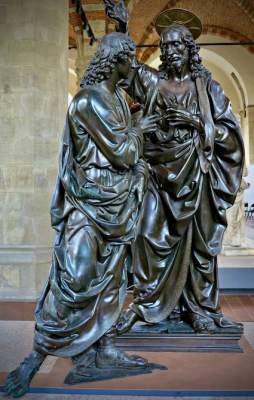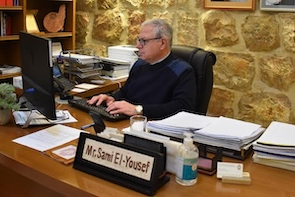Gospel in Art: The Feast of Saint Thomas, Apostle

Saint Thomas and Christ by Andrea del Verrocchio, cast bronze, sculpted 1467-1483 © Orsanmichele Church, Florence
Source: Christian Art
Gospel of 3 July 2024
John 20: 24-29
Thomas, called the Twin, who was one of the Twelve, was not with them when Jesus came. When the disciples said, 'We have seen the Lord', he answered, 'Unless I see the holes that the nails made in his hands and can put my finger into the holes they made, and unless I can put my hand into his side, I refuse to believe.' Eight days later the disciples were in the house again and Thomas was with them. The doors were closed, but Jesus came in and stood among them. 'Peace be with you' he said. Then he spoke to Thomas, 'Put your finger here; look, here are my hands. Give me your hand; put it into my side. Doubt no longer but believe.' Thomas replied, 'My Lord and my God!' Jesus said to him:
'You believe because you can see me. Happy are those who have not seen and yet believe.'
Reflection on the sculpture
Today we celebrate the feast of Saint Thomas the Apostle. Thomas has come to be known as 'Doubting Thomas,' yet there was much more to him than his doubt. The risen Lord's face-to-face encounter with Thomas in our Gospel reading today dispelled all his doubts and led him to one of the most profound professions of faith in all the Gospels: 'My Lord and my God.' Thomas's declaration affirms Christ's full humanity (my Lord) and full divinity (my God).
Because we live only in hope of such a face-to-face meeting with the Lord, there will always be some element of doubt in our own faith. As Paul says in his first letter to the Corinthians, "Now we see as in a mirror, dimly." The questions and doubts of our reasoning are an inevitable part of seeing dimly. They are not enemies of faith; rather, they can lead to its deepening. If we face our doubts and our questions honestly, as Thomas did, and bring them to each other and to the Lord, we too can reach a point where we can make Thomas' confession our own, 'My Lord and my God'.
Our late-15th-century sculpture by Andrea del Verrocchio beautifully captures the poignant interaction between Christ and Saint Thomas. The sculpture's expressive detail allows us to almost hear their profound dialogue. The Risen Christ stands in a regal pose, contrasting sharply with Saint Thomas' agitated, nervous, and merely human state. Originally crafted to occupy one of the fourteen niches on the exterior walls of the Orsanmichele Church in Florence, the figures were cast without modeled backs, intended to be viewed only from the front. This artistic choice emphasises the frontal interaction, drawing the viewer into the intimate and transformative moment shared by Christ and Thomas.
Born in Florence as Andrea di Michele di Francesco de' Cioni, Verrocchio trained under Donatello, whose influence is evident in his early works. Verrocchio established a highly successful workshop in Florence, which became a hub for aspiring artists. Among his most famous pupils were Leonardo da Vinci and Pietro Perugino, who would go on to become significant figures in their own right. Though Verrocchio was primarily known as a sculptor, he also painted. He died in Venice in 1488, leaving behind a legacy of artistic achievement that continued to inspire the trajectory of Renaissance art.
LINKS
Gospel in Art: https://christian.art/
Today's Reflection: https://christian.art/daily-gospel-reading/john-20-24-29-2024/


















